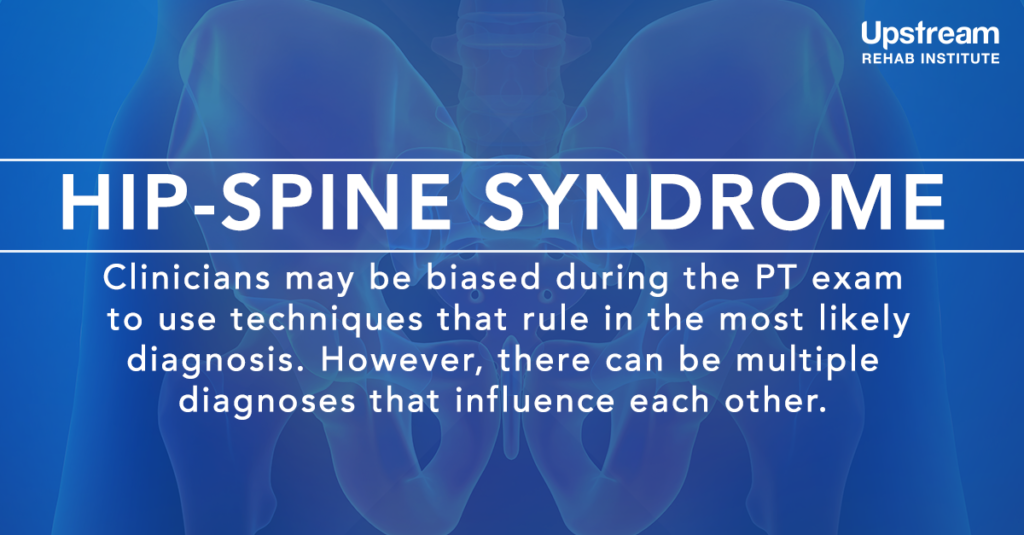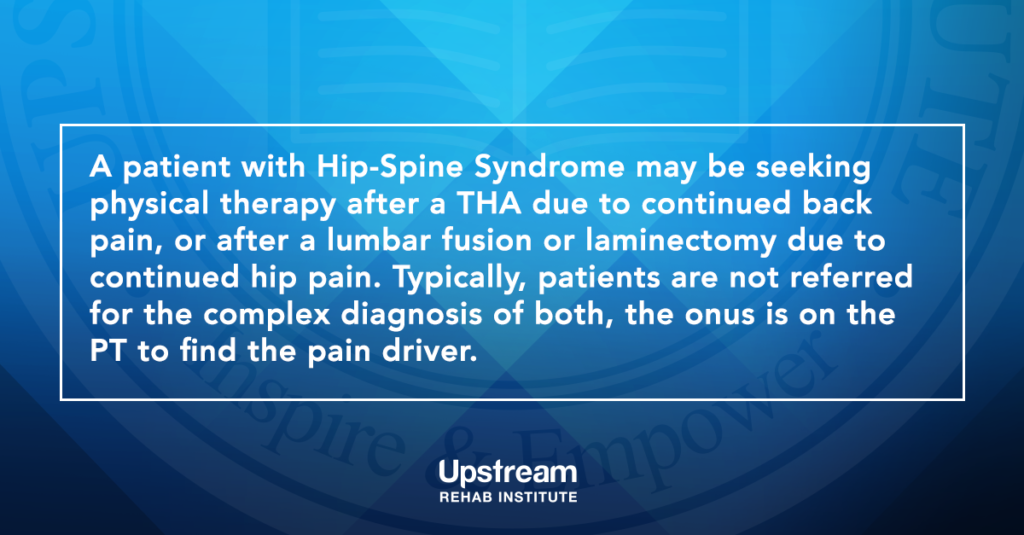Hip-Spine Syndrome
Sep 11 |Sarah Webster, PT, DPT, OCS, FAAOMPT

Chronic lower back pain is a common diagnosis in the outpatient physical therapy clinic. In the aging population, spinal stenosis and other degenerative conditions are on the rise.1 Hip pain is also common, but not as common as lower back pain. Similar to degenerative conditions in the spine, degeneration of the hip is also on the rise due to the sharp increase of the aging population.1 Outpatient physical therapists will encounter these conditions separate from each other and in patients where both conditions co-exist.
A strong predictor of the success of a physical therapy examination is to identify the primary generator of pain. Clinicians can be biased to use techniques that rule in the most likely diagnosis. However, in the aging population, there may be multiple diagnoses that are influencing each other. This is especially true in the hip spine complex. When both degenerative conditions of the hip and spine exist this is called hip-spine syndrome.2
This phenomena was first proposed in 1983 by Offierski and McNab3 but it is not well researched. However, this idea of co-existing diagnoses in the aging population makes sense. In fact, clinicians experience this practice pattern often. For example, consider a patient with back pain who had a total hip replacement and the back pain improved.2 Clinicians also often see patients with a primary complaint of back pain who demonstrate changes in hip mobility which affects their functional abilities. The complexity of this syndrome makes it hard to identify the primary pain generator. In a study looking at patients that present to a back pain clinic for primary back pain, up to 25% of the patients had significant pain contribution from the hip or SI joints, and an additional 10% had an undefined pain source even after diagnostic work-up.4 Failure to accept that both conditions exist may result in undertreating one and lead to poorer outcomes.
Diagnosis
Patients may demonstrate a loss in hip flexion and internal rotation similar to the pattern we typically see with degenerative hip dysfunction. Pain may present in the groin or the posterior hip. Khan et al5 reported 84.3% sensitivity and 70.3% specificity for groin pain in patients with hip osteoarthritis (OA). Patients with groin pain have been shown to be seven times more likely to have only a hip disorder or a hip-spine disorder than a spine-only disorder. In the study by Khan,5 no patient with hip pathology had pain referred to the lumbar spine, although pain can often refer to the knee. Patients that present with hip-spine syndrome also demonstrates signs of spinal degeneration including a possible lack of spinal extension, difficulty in standing, difficulty with walking, and pain referral down the leg. They may demonstrate a forward posture due to tight hip flexors and, therefore, have weakened gluteal muscles further perpetuating the functional difficulties of walking and standing.
A positive femoral tension sign is nearly five times more likely to be noted in persons with lumbar stenosis than in those with hip pathology only. However, persons with hip flexion contracture can have a false-positive femoral tension sign; thus, this test is unreliable in the context of hip-spine syndrome.1 A patient with hip-spine syndrome may be seeking physical therapy after a total joint replacement and may report continued back pain, or possibly after a joint fusion or laminectomy with continued hip pain. Typically they are referred for either back pain or hip pain but not the complex diagnosis of both.

Treatment
For the evidence-based clinician, this diagnosis is difficult to treat because of the lack of relevant research exploring this complex diagnosis. However, some good research does exist to treat the separate diagnoses of hip osteoarthritis and chronic back pain or lumbar stenosis. Burns and colleagues6 suggested that patients can be successfully treated with manual therapy directed at the hip with exercise following to reinforce gains. Techniques that are included within this study include a long axis distraction thrust manipulation, supine inferior non-thrust mobilization, and prone posterior-to-anterior non-thrust mobilization in neutral or flexion/abduction/external rotation positions. Mobilizations and manipulations can affect the central nervous system, providing a neurophysiological effect to improve pain. Perhaps as suggested by Wainner and colleagues7 and further explored in the research by Burns et al,6 a regional approach is appropriate. This may include mobilizing the hip anteriorly to affect hip extension and both the hip and spine’s ability to perform during functional activities.
Considering the mechanism of the loss of hip extension and the extra pressure it puts on the spine, then restoring hip extension to alleviate spinal pain makes sense. Some orthopedic research does exist regarding the relationship between hip extension and the lumbar spine. Researchers suggested that limited terminal hip extension significantly increased L3-4 and L4-5 lumbar facet joint load when compared with unaffected hips.8 This study directly linked the idea that hip disorders that limit extension could increase back pain. Another study looked at patients with back pain and the altered kinematics of hip function during sit to stand. Patients with back pain have altered coordination between the hip and back and poorer hip extension affecting the back during a sit to stand activity.9 After performing manual techniques to restore hip mobility, the natural progression should be exercise to continue to reinforce the gains made by manual techniques. Performing step ups both forward and lateral, bridges, and sit to stand are just a few functional ways to reinforce hip extension strength.
More research is emerging in the orthopedic literature regarding this complex diagnosis with regard to appropriate surgical candidates and conservative treatment such as injections and corticosteroid epidurals. Eneqvist and colleagues10 examined patients who first had the lumbar surgery, then proceeded later on to total hip replacement. Their research concluded that lumbar spinal surgery prior to total hip replacement was associated with less reduction of pain, worse health-related quality of life, and less satisfaction one year after total hip replacement. This can assist in educating patients who are contemplating surgery compared to conservative care.
REFERENCES
- Devin C, McCullough K, Morris B, Yates A, Kang J. Hip-spine syndrome. J Am Acad Orthop Surg 2012; 20: 434-442
- Ben-Galim P, Ben-Galim T, Rand N, Haim A, Hipp J, Dekel S, Floman Y. Hip-spine syndrome: the effect of total hip replacement surgery on low back pain in severe osteoarthritis of the hip. Spine (Phila Pa 1976).
- Offierski C, MacNab I: Hip-spine syndrome. Spine (Phila Pa 1976) 1983; 8(3):316-321.
- Sembrano J, Polly W. How often is low back pain not coming from the back? Spine 2009; 34(1): E27-E32.
- Khan. Hip osteoarthritis: where is the pain? Ann R Coll Surg Engl 2004; 86: 119–121.
- Burns S, Mintken P, Austin G, Cleland J. Short-term response of hip mobilizations and exercise in individuals with chronic low back pain: a case series. JMMT 2011; 19( 2): 100-107.
- Wainner R, Whitman J, Cleland J, Flynn T. Regional interdependence: a musculoskeletal examination model whose time has come. J Orthop Sports Phys Ther 2007;37(11):658-60.
- Gómez-Hoyos J, Khoury A, Schröder R, Johnson E, Palmer I, Martin H. The Hip-spine effect: a biomechanical study of ischiofemoral impingement effect on lumbar facet joints. The Journal of Arthroscopic & Related Surgery 2017; 33(1):101-7.
- Shum G, Crosbie J, Lee R. Effect of Low Back Pain on the Kinematics and Joint Coordination of the Lumbar Spine and Hip During Sit-to-Stand and Stand-to-Sit. Spine 2005; 30(17): 1998-2004.
- Eneqvist T, et al. Paper #2337. Presented 2 June 2017 at 12:10 – at the 18th EFORT Annual Congress; 31 May – 2 June 2017; Vienna. Accessed by Helio orthopedics today on July 13 2018.
Continuing Education Courses to consider: LP: Comprehensive Management of the Lumbopelvic Region
